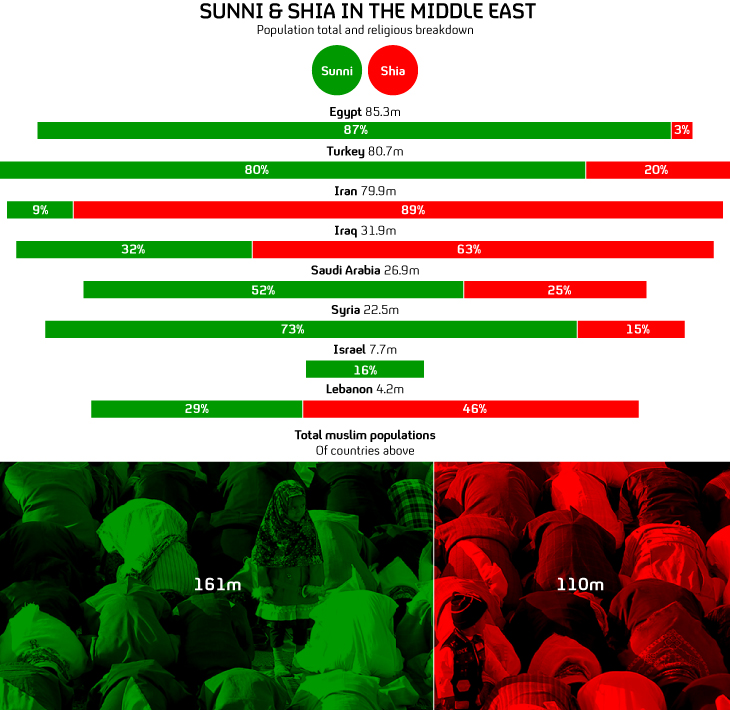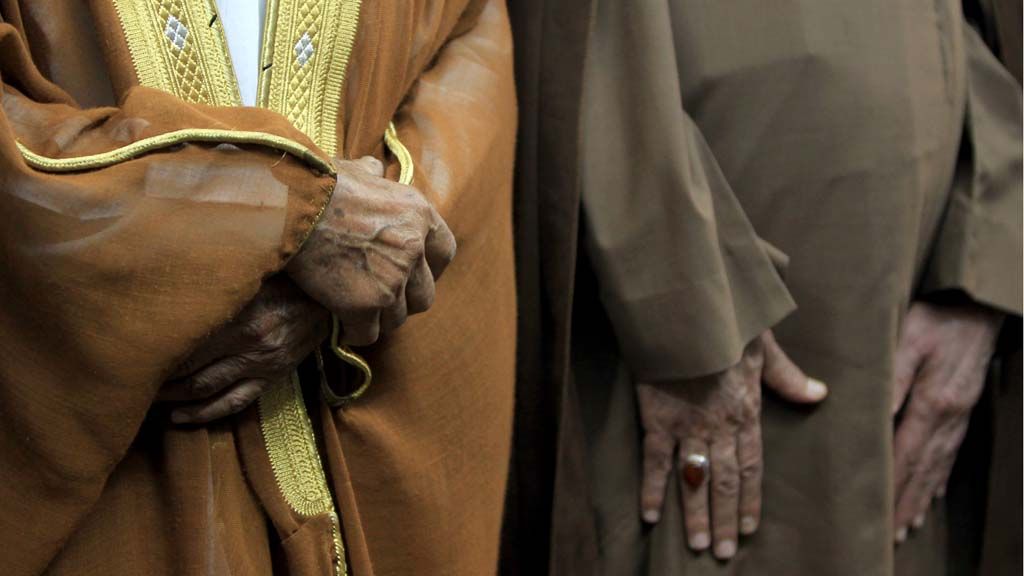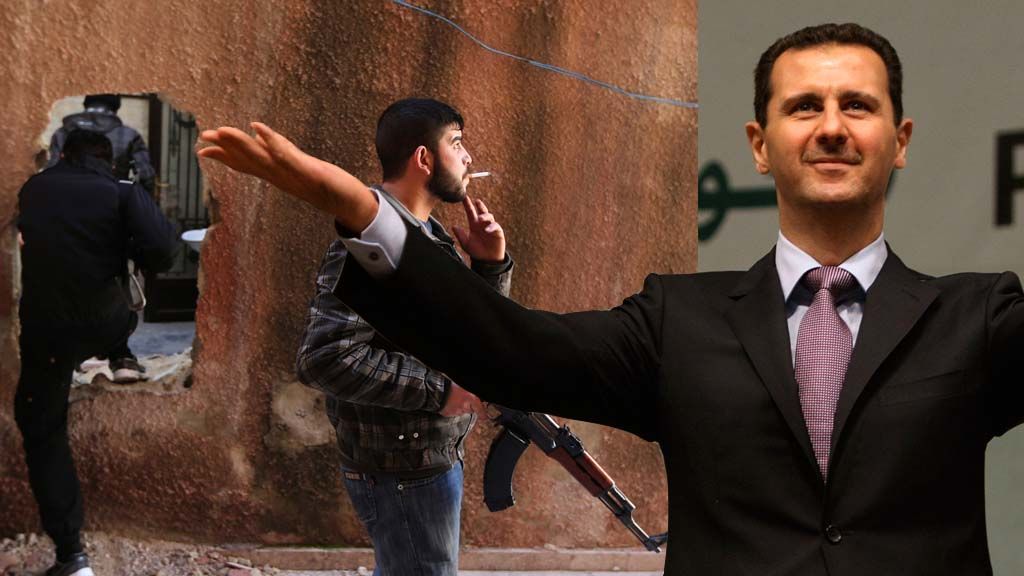At the heart of Syria's bloody civil war is one of the oldest religious divide in history - that between Sunni and Shia Muslims. But what are the differences between them?

(graphic, Ciaran Hughes)
Why the difference?
The split between Sunni and Shia Muslims occurred following the death of the Prophet Muhammad, and was bound up in who should succeed him.
One group, later to become the Sunnis, believed in appointing the successor under Arab tribal tradition - the other, the Shias, believed Muhammad's successor should be from his family, and backed Ali - Muhammad's cousin - who was also his son-in-law.
There was a schism very early on and theological differences developed from this. Dr Carool Kersten
The name Sunni comes from "Ahl-a-Sunnah", meaning the "people of tradition", denoting the traditional approach to appointing Muhammad's successor. Shia is derived from "Shiat Ali", meaning "the party of Ali".
Sunni Muslims appoint a caliph as leader, whilst Shia Muslim's appoint an imam. According to Dr Carool Kersten, senior lecturer in the study of Islam and the Muslim world at King's College London, the divide denotes a split in what was seen as the role of Muhammad's successors.
"There was a schism very early on and theological differences developed from this. The imams were considered to be infallible, whilst for the Sunnis the caliph was just a man, there to maintain law and order."
Read International Editor Lindsey Hilsum's blog: War, politics and sectarianism in Syria
However, the split between the groups was not definitive straight away. Ali was appointed by the Sunni Muslims as the fourth caliph - in that moment uniting the two factions' leaders, both imam and caliph, into one person. He survived five years before dying in mysterious circumstances.
Ali's son Hussein was not appointed caliph under the Sunnis, despite being the rightful heir under Shia beliefs. His death at the hands of the Sunni Umayyad family at the Battle of Karbala made him a martyr for the Shia cause. According to Dr Kersten, this was the decisive moment in splitting the Sunnis from the Shias.
"Karbala is the moment," he told Channel 4 News. "There is a chant that you hear which goes 'Every day is Karbala. We are all Hussein'."
What are the differences today?
Geographically, the Sunni/Shia picture differs across the Middle East and the rest of the world (see graphic, above). Sunnis are the more dominant form of Islam - at least 80 per cent of Muslims worldwide. Some Sunni dominated countries include Saudi Arabia, Egypt, Turkey and Syria (see more on Syria, below).

However, Shia Muslims are the majority in some other countries such as Iran, Iraq, and more recently, Lebanon.
The ancient split has led to some different practices and approaches to theology being adopted by the different groups - but they share fundamental beliefs such as the "oneness" of Allah, that Muhammad was the last prophet, prayer and fasting.
It would be overly easy to say Shias are more moderate than Sunnis. You can find extreme elements on both sides of the equation. Dr Carool Kersten
However, rivalries between the groups exist. The deaths of Ali and Hussein, and the fact that, as the minority, Shias have endured a more unpleasant history of repression, creates a theme of martyrdom throughout Shia history.
Sunnis, who often see themselves as the more traditional branch of Islam, have refered to Shias as "rejectors", because of their perceived rejection of tradition.
Western perception is often that the Sunni branch is more extreme than Shi'ism - something increased by the fact that al-Qaeda adopts a Sunni Salafist doctrine.
However, according to Dr Kersten, it is not as simple as that. "It is overly easy to make that kind of distinction," he said. "If you talk about Iran (where Shia are dominant), western opinion doesn't view them as the moderate type. Some of the language that comes out of Iran definitely doesn't fit that view.
"It is more political than anything else. Hezbollah, for example, represents a long-term repressed Shia minority - and they have certainly been becoming more beligerent.
"It would be overly easy to say Shias are more moderate than Sunnis. You can find extreme elements on both sides of the equation."
How has this been played out in Syria?
Syria is a majority Sunni country, but has been governed under Assad by a Shia minority (image, below). The picture is, in simple terms, the opposite of the situation in Iraq before the Iraq war - where the minority Sunnis led by Saddam Hussein governed the majority Shia community.

Put simply, the rebels are Sunni and the government is Shia.
However, divisions within the Shia branch mean that the situation is more confused. The regime is Alawite, which is a sub branch of a Shia faction known as the "Seveners". The Seveners believe there were seven true imams. Similarly there is a larger faction called the "Twelvers" and a smaller faction called the "Fivers".
There is a clear sectarian division between the Sunnis and the Shias on the battlefields of Syria. Raffaello Pantucci, RUSI
Iran is governed by "Twelvers", and its sponsored militant organisation Hezbollah is also "Twelver".
However, Dr Kersten says, within the Shia branch the differences have been papered over in favour of global political aims. "In many ways the enemy of my enemy is my friend," he said.
On the Shia side there have also been influxes of fighters from Shia-majority country Iraq, fighting for the regime.
Saudi Arabia and Qatar, both Sunni countries, have provided support to the rebels.
In April, 500 fighters from Jordan, an overwhelmingly Sunni country, joined extremist rebel group Al-Nusra to fight against the regime.
The war in Syria has become a "magnet" for Shia and Sunni fighters alike, says Raffaello Pantucci, senior research fellow at the Royal United Services Insitute - with "groups like Hezbollah siding with the government, and Sunni clerics shouting about supporting the rebels."
"There is a clear sectarian division between the Sunnis and the Shias on the battlefields of Syria," he told Channel 4 News.
"It is a narrative that came out in the recent battle in Qusair. There was an influx of Hezbollah fighters.
"We are also hearing that there are a lot more Shias from Iraq coming into the battlefield, who are alarmed at the destruction of certain monuments and sites of religious significance and are coming in to protect them.
"We are also seeing a hug influx of people coming in for the Sunni side. Some of these are people who hold extremist jihadist views, some are footloose young men interested in fighting on the battlefield - and everything in between."